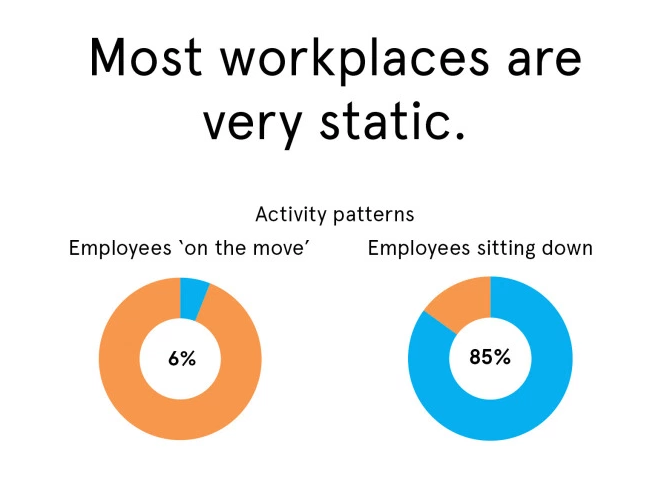Staff wellbeing is increasingly on the radar of the HR function in businesses. However, the impact that the design of the space can have upon it, is often missed.
Spacelab’s Director of Workplace Consultancy, Rosie Haslem, shares some tips on designing spaces to maximise staff wellbeing, developed through findings from Spacelab’s database of over 20,000 people and 30 businesses in the last five years:
1. Encourage movement
Lack of workplace activity is contributing to our sedentary lifestyles. On average, 85% of a workforce are sitting down at any one point in time, and only 6% are on the move. Increasing visibility across a workspace and opening up circulation routes can help encourage workplace movement and activity.

Here’s a white paper you may like: Creating Agile Organisations
2. Provide alternative spaces to the desk
Not having the right ‘tools’, or spaces, to carry out a job can lead to stress, as well as reduced productivity. The nature of work is changing – we have observed that on average, desks are occupied just 44% of the time, indicating that many work activities actually require a space other than a desk. It is essential to provide the right range and mix of spaces to support all working needs and activities.

3. Make space for social interaction and collaboration
Humans are social creatures, so enabling social interaction with colleagues, as well as work-based collaboration, is a key part of people’s enjoyment of their job. Providing spaces away from desks for socialising, as well as unplanned interactions, can increase staff satisfaction and productivity.
4. Allow quiet space to concentrate
On average, 41% of people disagree or strongly disagree with the statement ‘my workspace supports quiet and concentrated work’. This real or perceived barrier to effective working can be a source of workplace stress and is a commonly-stated argument against open plan working. Providing spaces for quiet, concentrated, or confidential working can allay these fears and help accommodate all working needs.
5. Engage staff in the process of workplace change
People-centred workplace design, and a people-centred process of workplace design, can boost staff satisfaction. In our most recent post-occupancy study we found that satisfaction with the environment increased from 66% (pre) to 92% (post), and there was a drop in staff turnover rates from 42% to 19% – due to both the engagement of all staff from the start of the process, and then the more supportive workplace design thereafter.
 In summary, sedentary lifestyles, stress and disengagement can have a negative impact on the wellbeing of your staff. Understanding the complexity of your people – their inherent differences and varying needs throughout the working day – provides an opportunity to tailor your space in a way that enhances their wellbeing. Gaining insights and an understanding of your own staff needs and working cultures will help you to maximise the positive impact you can have.
In summary, sedentary lifestyles, stress and disengagement can have a negative impact on the wellbeing of your staff. Understanding the complexity of your people – their inherent differences and varying needs throughout the working day – provides an opportunity to tailor your space in a way that enhances their wellbeing. Gaining insights and an understanding of your own staff needs and working cultures will help you to maximise the positive impact you can have.
First posted on 8th August, 2016 on Spacelab https://wearespacelab.wordpress.com/2016/08/08/five-tips-for-designing-a-workspace-that-improves-staff-wellbeing/
Spacelab are recognised partners of Condeco.